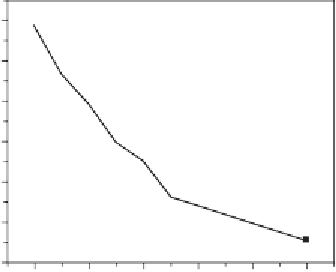Environmental Engineering Reference
In-Depth Information
3.5
3.0
2.5
2.0
1.5
1.0
0.5
0
2
4
6
8
10
Boron nitride, wt %
Figure 13.6
Oxygen permeability of the composites as a function of boron nitride content
at a pressure of 0.010 MPa [23].
Polymer-based composites which have been shown to provide barrier
to oxygen are being studied for packaging applications. h e oxygen per-
meability of virgin chitosan and chitosan/BN composites can be seen in
Figure 13.6. As chitosan is a porous polymer, the dispersion of boron nitride
in chitosan matrix may provide the huddles for oxygen entrance, whereas
virgin chitosan may have voids for oxygen permeation [23]. Oxygen per-
meability of chitosan/BN composites was conducted to measure the ef ect
of boron nitride concentrations on the chitosan matrix. h e oxygen l ow
rate through all the composites was observed to be less in comparison with
the virgin chitosan at pressure 0.010 MPa (Figure 13.6). It was found that
the l ow rate decreased with an increase in percentages of boron nitride
loading. h e substantial reduction in oxygen permeability may be due to
the dispersion of boron nitride within the chitosan matrix. h e oxygen l ow
rates through all composites were also observed to be less in comparison
with the virgin chitosan at dif erent pressures up to 0.013 MPa.
Oxygen permeability of the synthesized cellulose/BN nanobiocompos-
ites was conducted to measure the ef ect of boron nitride concentrations
on oxygen barrier properties of the cellulose matrix [24]. h e oxygen l ow
rate through all the nanobiocomposites was observed to be less in compar-
ison to the virgin cellulose at constant pressures of 2 psi (Figure 13.7a). It
was found that the l ow rate was decreased with an increase in percentage
of boron nitride loading. h e remarkable reduction in oxygen permeability
was due to nanostructure dispersion of boron nitride within the cellulose
matrix at dif erence pressure up to 2 psi (Figure 13.7b).








Search WWH ::

Custom Search